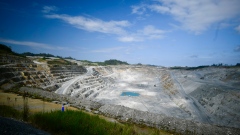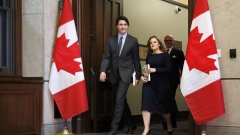Jan 11, 2024
Trudeau botched immigration surge, Canada's top bank economists say
, Bloomberg News
How non-permanent resident immigration is helping Canada avoid a deeper recession
Canada’s current immigration policy — among the most open in the world — is now causing economic damage and needs to be reconsidered, according the country’s top economists.
Prime Minister Justin Trudeau’s decision to dramatically increase immigration — and allow a flood of temporary workers and international students — without providing proper support has created a laundry list of economic problems, including higher inflation and weak productivity, chief economists at Canada’s biggest banks said Thursday during a wide-ranging panel discussion in Toronto.
“Frankly I’m surprised we screwed it up because we sit in such a privileged position in Canada,” Beata Caranci, chief economist at Toronto Dominion Bank, told a packed audience at an Economic Club of Canada event.
Unlike many other countries, including the U.S., Canada is not dealing with poorly controlled flows of migrants across its land borders and has had time to think about the implications of its policies, Caranci said. “We designed our own policy, we put it in place, we implemented it, and we still screwed it up.”
Canada accepted about 455,000 new permanent residents in the year to Oct. 1 while bringing in more than 800,000 non-permanent residents, a category that includes temporary workers, foreign students and refugees. With a population growth rate of 3.2 per cent, it’s growing faster than any Group of Seven nation, China or India.
While there are annual targets for permanent residents, there is no cap on international-student permits and the government has made it easier for employers to hire temporary foreign workers.

‘POPULATION TRAP’
“I’ll put it bluntly: We’ve fallen into the population trap,” said Stéfane Marion, chief economist at National Bank of Canada. An increase in the standard of living is no longer possible because “you don’t have enough savings to stabilize your capital to labor ratio.”
Faced with a backlash over housing costs, Trudeau has acknowledged a need for changes. His immigration minister, Marc Miller, has pledged to make it harder for colleges to boost foreign enrollment without providing adequate housing or services. Still, the government is under pressure to maintain high immigration levels as older workers retire and the fertility rate falls.
While the federal government is trying to encourage more rental housing construction along the way, “the numbers just don’t add up,” said Avery Shenfeld, chief economist at CIBC Capital Markets. “I’m a bit surprised that the government is moving fairly slowly on this. I think there’s some urgency to bring these numbers of students and temporary workers into better balance with the arithmetic of our homebuilding strategy, because the two are working at cross-purposes.”
The problem is worsened in provinces that have restricted funding to post-secondary institutions, forcing the schools to make up the lost revenue with international students, Shenfeld said. The result is community colleges with “branch plants” full of international students in Toronto office buildings, he said. “It’s just really a tuition-making machine.”
None of the economists suggested Canada should shift to a restrictive immigration policy, rather that it be more deliberate about matching the inflow of people to what the country can handle.
Canada has tended to rely on immigration to stanch complaints from businesses about their difficulty hiring, several economists said. While that’s understandable, “in a way we made it too easy for businesses to hire,” said Jean-Francois Perrault, chief economist at Bank of Nova Scotia. He pointed to the U.S., which has much tougher immigration policies and higher productivity. “Immigration policy made it cheaper to bring people in rather than investing.”
Disastrously weak productivity and housing affordability are the biggest challenges facing the Canadian economy, said Douglas Porter, Bank of Montreal’s chief economist, and strong population growth is clearly a factor for both.
There are other factors at play, of course. A lack of innovation and business investment have weighed on Canadian productivity for decades, said Craig Wright, chief economist at Royal Bank of Canada. He said soaring rents aren’t just caused by immigration pressure — high house prices and interest rates are pushing permanent residents out of home ownership into rental housing.
A Desjardins Securities Inc. report this week found that if Canada were to shut the door to temporary residents right now, real gross domestic product would drop and the recession would last twice as long.
That leaves the Bank of Canada in a difficult spot and explains why it will have to cut rates in 2024, Caranci said, even though housing costs are still forcing inflation above its two per cent target. She expects the central bank will start to shift its communication — and remind markets that inflation is about breadth and they are not solely responsible for shelter inflation.
“If they don’t do that, you absolutely get into a recession scenario and potentially a hard recession scenario,” she said.
With assistance from Erik Hertzberg and Laura Dhillon Kane











